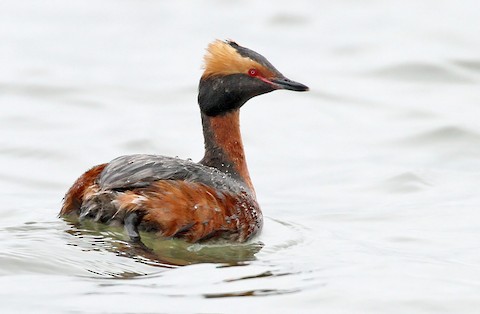As migration nears, birds take on winter colors
- The common loon shifts from its more familiar, bold-patterned black and white plumage to a more subdued gray and white for winter. The coloring makes it less conspicuous on the open waters where it winters, such as Lake Michigan. (Betsy Bloom/Daily News photo)
- These photos show the contrast between what a horned grebe looks like in colorful breeding plumage, above, and when it switches to winter coloration.
- Ryan Brady/Wisconsin Department of Natural Resources photos

The common loon shifts from its more familiar, bold-patterned black and white plumage to a more subdued gray and white for winter. The coloring makes it less conspicuous on the open waters where it winters, such as Lake Michigan. (Betsy Bloom/Daily News photo)
My 20-something nephew, visiting a weekend ago, noticed a loon leisurely diving for fish on Six Mile Lake.
It was far out, yet I still managed a couple decent photos with my new lens. Later, as I was focused on some of the late-season meadowhawk dragonflies, it popped up quite close to the dock. Loons frequently seem indifferent, even perhaps curious, about humans.
When my nephew joined me on the dock and I showed him the crisp loon close-ups, he remarked he’d never seen a loon that color. It was dull gunmetal gray above, with scallops of white on back — so unlike the bold white cobblestone back pattern and star spots against black, along with the striped necklace that is the familiar image of a common loon for most people.
But that’s the loon in full breeding plumage, a look meant to impress its prospective or ongoing mate — and broadcast its health and maturity through its feathers. Spring is dress-up time for birds, be it the classic black and white formalwear of the loons or vibrant colors of such songbirds as male scarlet tanagers, indigo buntings and waterbirds like horned grebes.
As fall migration approaches, however, many of these birds ditch their more well-known looks for something suitably subdued for the winter season. They’ll appear more like an immature or female member of their species.

These photos show the contrast between what a horned grebe looks like in colorful breeding plumage, above, and when it switches to winter coloration.
Male scarlet tanagers lose the red that gives them their name, becoming green-yellow, though keeping the jet-black wings. Indigo bunting males go from being deep blue overall to only some scattered spots of color.
It’s a matter of function over style. Spring, at least for the males of many bird species, is all about drawing attention. Winter is time to blend into the surroundings, which is why so many of them adopt the more drab look of the females that need to be able to avoid detection while sitting on the nest.
So the loons, many of them headed to Lake Michigan to hang out offshore until spring, turn gray to better match the palette of the wintry water and skies.
While an adult loons may have few predators, it still is prudent not to draw the eye of a hungry bald eagle by standing out among the waves.
Several of the grebe family undergo a similar transformation for the same reason. Horned grebes, which regularly turn up in the region as they migrate to and from their nesting grounds in the far north, are stunning in the spring, with deep rust bodies, bushy black cheeks and a flaming orange-yellow stripe that extends from eye to the back of the head — its “horns.” But by fall, the grebe has lost its ruddy body and those glorious golden eyebrows, donning the same gray and white combination as the loons.

Ryan Brady/Wisconsin Department of Natural Resources photos
At the feeders, American goldfinches go so khaki in winter they can at first glance appear to be pine siskins — the siskins have strong streaks on breast and back.
Neotropical migrants like the scarlet tanagers will spend the winter far south, in Central and even South America, using the more abundant food supplies there to sprout a new set of feathers in time to return to breeding areas next spring.
—–
The Michigan Department of Natural Resources this week recommended removing bird feeders or hanging them out of reach to discourage bears looking to pack on a few more pounds just before hibernation.
“Black bears likely will enter their dens for hibernation by December, but timing can vary depending on food availability,” the DNR advised. “Bears may start entering dens in early October, with females typically entering dens earlier than males. Prior to hibernation, bears spend months foraging for foods rich in calories to bulk up their fat reserves. In the bear world, fat means survival, as they can lose up to one-third of their body weight during hibernation.”
Bears have an excellent sense of smell and will follow their nose to find food. Even when natural foods — acorns, hickory nuts and hazelnuts — are abundant, bird seed in feeders often prove too easy and tempting a target for the bear to pass up, according to the DNR. Bears also may be attracted to grills with food debris, unsecured trash or outdoor pet foods.
The more the bear becomes comfortable with such behavior, in close proximity to humans, the more likely it could become a nuisance, “which ultimately may lead to an unfortunate outcome for the bear,” said Rachel Leightner, wildlife outreach coordinator for the DNR’s Wildlife Division.
Additional tips and information about preventing potential conflicts with bears can be found at Michigan.gov/Wildlife.
Betsy Bloom can be reached at 906-774-2772, ext. 240, or bbloom@ironmountaindailynews.com.








